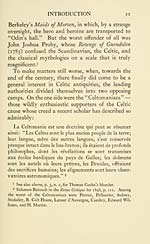Download files
Complete book:
Individual page:
Thumbnail gallery: Grid view | List view

lo INTRODUCTION
The Vision^ though the Critical Review had itself
been guilty of the same offense in 1784, as had the
Monthly Review in 1775; and that the same general
mistake was made in Chatterton's Battle of Hastings^
Bowles's St. Michael's Mount, Sayers's Moina, and
in one of John Leyden's notes to his Ode on Scottish
Scenery and Manners.
In order to emphasize the frequency with which
this confusion between Norse and Celtic arose in
the eighteenth century, I venture to point out a
few other cases, of which Professor Farley has made
no mention. In 1761 there appeared in the Annual
Register, pp. 236-237, an English prose translation
of The Incantation of Hervor with the palpably ab-
surd title "Fragments of Celtic Poetry, from Glaus
Verehus, a German writer; hterally translated." A
few years later Pierre Chiniac de la Bastide Duclaux
spoke of *'les Germains qui suivoient la Religion
des Gaulois leur Ayeux." ^ Again Richard Polwhele
in his Fate of Llewelyn; or, the Druid's Sacrifice in-
congruously introduced the ''Fatal Sisters" in a
distinctly Celtic setting; and Jerningham appar-
ently confused Norse and Celtic imagery in his Rise
and Progress of Scandinavian Poetry. In 1793 Joseph
Jefferson implied that Druids were priests of Thor
and Woden, and made the matter worse in an am-
biguous note. Equally amusing is George-Monck
^ In his Discours sur la nature et les dogmes de la religion Gauloise
(Paris, 1769), p. 60.
The Vision^ though the Critical Review had itself
been guilty of the same offense in 1784, as had the
Monthly Review in 1775; and that the same general
mistake was made in Chatterton's Battle of Hastings^
Bowles's St. Michael's Mount, Sayers's Moina, and
in one of John Leyden's notes to his Ode on Scottish
Scenery and Manners.
In order to emphasize the frequency with which
this confusion between Norse and Celtic arose in
the eighteenth century, I venture to point out a
few other cases, of which Professor Farley has made
no mention. In 1761 there appeared in the Annual
Register, pp. 236-237, an English prose translation
of The Incantation of Hervor with the palpably ab-
surd title "Fragments of Celtic Poetry, from Glaus
Verehus, a German writer; hterally translated." A
few years later Pierre Chiniac de la Bastide Duclaux
spoke of *'les Germains qui suivoient la Religion
des Gaulois leur Ayeux." ^ Again Richard Polwhele
in his Fate of Llewelyn; or, the Druid's Sacrifice in-
congruously introduced the ''Fatal Sisters" in a
distinctly Celtic setting; and Jerningham appar-
ently confused Norse and Celtic imagery in his Rise
and Progress of Scandinavian Poetry. In 1793 Joseph
Jefferson implied that Druids were priests of Thor
and Woden, and made the matter worse in an am-
biguous note. Equally amusing is George-Monck
^ In his Discours sur la nature et les dogmes de la religion Gauloise
(Paris, 1769), p. 60.
Set display mode to: Large image | Transcription
Images and transcriptions on this page, including medium image downloads, may be used under the Creative Commons Attribution 4.0 International Licence unless otherwise stated. ![]()
| Early Gaelic Book Collections > Ossian Collection > Celtic revival in English literature > (28) |
|---|
| Permanent URL | https://digital.nls.uk/78489102 |
|---|
| Description | Selected books from the Ossian Collection of 327 volumes, originally assembled by J. Norman Methven of Perth. Different editions and translations of James MacPherson's epic poem 'Ossian', some with a map of the 'Kingdom of Connor'. Also secondary material relating to Ossianic poetry and the Ossian controversy. |
|---|
| Description | Selected items from five 'Special and Named Printed Collections'. Includes books in Gaelic and other Celtic languages, works about the Gaels, their languages, literature, culture and history. |
|---|

